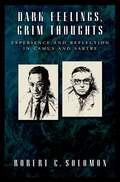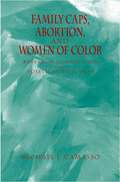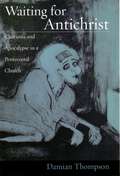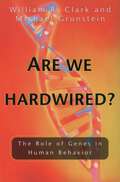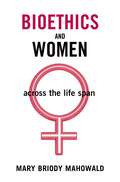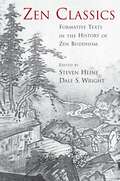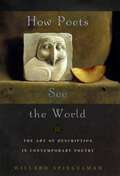- Table View
- List View
Dark Feelings, Grim Thoughts: Experience and Reflection in Camus and Sartre
by Robert C. SolomonIn the same spirit as his most recent book, Living With Nietzsche, and his earlier study In the Spirit of Hegel, Robert Solomon turns to the existential thinkers Albert Camus and Jean-Paul Sartre, in an attempt to get past the academic and political debates and focus on what is truly interesting and valuable about their philosophies. Solomon makes the case that--despite their very different responses to the political questions of their day--Camus and Sartre were both fundamentally moralists, and their philosophies cannot be understood apart from their deep ethical commitments. He focuses on Sartre's early, pre-1950 work, and on Camus's best known novels The Stranger, The Plague, and The Fall. Throughout Solomon makes the important point that their shared interest in phenomenology was much more important than their supposed affiliation with "existentialism." Solomon's reappraisal will be of interest to anyone who is still or ever has been fascinated by these eccentric but monumental figures.
The Making of the "Rape of Nanking": History and Memory in Japan, China, and the United States
by Takashi YoshidaOn December 13, 1937, the Japanese army attacked and captured the Chinese capital city of Nanjing, planting the rising-sun flag atop the city's outer walls. What occurred in the ensuing weeks and months has been the source of a tempestuous debate ever since. It is well known that the Japanese military committed wholesale atrocities after the fall of the city, massacring large numbers of Chinese during the both the Battle of Nanjing and in its aftermath. Yet the exact details of the war crimes--how many people were killed during the battle? How many after? How many women were raped? Were prisoners executed? How unspeakable were the acts committed?--are the source of controversy among Japanese, Chinese, and American historians to this day. In The Making of the "Rape of Nanking Takashi Yoshida examines how views of the Nanjing Massacre have evolved in history writing and public memory in Japan, China, and the United States. For these nations, the question of how to treat the legacy of Nanjing--whether to deplore it, sanitize it, rationalize it, or even ignore it--has aroused passions revolving around ethics, nationality, and historical identity. Drawing on a rich analysis of Chinese, Japanese, and American history textbooks and newspapers, Yoshida traces the evolving--and often conflicting--understandings of the Nanjing Massacre, revealing how changing social and political environments have influenced the debate. Yoshida suggests that, from the 1970s on, the dispute over Nanjing has become more lively, more globalized, and immeasurably more intense, due in part to Japanese revisionist history and a renewed emphasis on patriotic education in China. While today it is easy to assume that the Nanjing Massacre has always been viewed as an emblem of Japan's wartime aggression in China, the image of the "Rape of Nanking" is a much more recent icon in public consciousness. Takashi Yoshida analyzes the process by which the Nanjing Massacre has become an international symbol, and provides a fair and respectful treatment of the politically charged and controversial debate over its history.
Incidence and Economic Burden of Injuries in the United States
by Eric A. Finkelstein Phaedra S. Corso Ted R. MillerInjuries are one of the most serious public health problems facing the United States today. Through premature death, disability, medical cost and lost productivity, injuries impact the health and welfare of all Americans. Deaths only begin to tell the story. Although many injuries are minor, a large proportion result in fractures, amputations, burns, or other significant injuries that have far-reaching consequences. Now, for the first time in over 15 years, we have comprehensive estimates of the impact of these injuries in economic terms. This book updates a landmark Report to Congress from 1989. Since the report, no undertaking has addressed the incidence and economic burden of injuries with more timely data, despite major changes in the fields of prevention, reporting, and surveillance. Since the mid-eighties, new safety technologies have been developed to prevent injuries or to decrease the severity of injuries, and new policies and laws have been enacted to promote injury prevention. Chapter topics include incidence by detailed categorizations, lifetime medical costs and productivity losses as a result of injuries, and a discussion of recent trends. Lavishly illustrated with tables and graphs, this volume is a valuable reference for public health practitioners, researchers, and students alike.
In the Shadow of Death: Restorative Justice and Death Row Families
by Elizabeth Beck Sarah Britto Arlene AndrewsThe press called Martin's actions a "crime spree." Already convicted of armed robbery, Martin was facing the death penalty. In less than two weeks the jury would decide his fate. Terrified that his son would be sentenced to die, Phillip did the only thing he felt he could do: in an act of faith and desperation in his garage with the car exhaust running, Phillip made the consummate sacrifice to spare his son the ultimate punishment. Ironically, his suicide presented Martin's with another chance at life; the jury, moved by Martin's loss, spared his life. Phillip's story-like those of the other parents, siblings, children, and cousins chronicled in this book-vividly illustrates the precarious position family members of capital offenders occupy in the criminal justice system. At once outsiders and victims, they live in the shadow of death, crushed by trauma, grief, and helplessness. In this penetrating account of guilt and innocence, shame and triumph, devastating loss and ultimate redemption, the voices of these family members add a new dimension to debates about capital punishment and how communities can prevent and address crime. Restorative justice theory, which views violent crime as an extreme violation of relationships; searches for ways to hold offenders accountable; and meets the needs of victims and communities torn apart by the crime, organizes these narratives and integrates offenders' families into the process of transforming conflict and promoting justice and healing for all. What emerges from hundreds of hours' worth of in-depth interviews with family members of offenders and victims, legal teams, and leaders in the abolition and restorative justice movements is a vision of justice strongly rooted in the social fabric of communities. Showing that forgiveness and recovery are possible in the wake of even the most heinous crimes, while holding victims' stories sacred, this eye-opening book bridges the pain of living in the shadow of death with the possibility of a reparative form of justice. Anyone working with victims, offenders, and their families-from lawyers and social workers to mediators and activists-will find this riveting work indispensable to their efforts.
Healthier Societies: From Analysis to Action
by Jody Heymann, Clyde Hertzman, Morris L. Barer and Robert G. EvansExtensive research has shown that social factors are as important as biological ones in determining health, and their impact is enormous in both adults and children. The challenge of changing public policies and programs remains. Healthier Societies: From Analysis to Action addresses the fundamental questions which will lead the way toward countries investing seriously in improving social conditions, as a way of improving population health. The book is divided into three parts. Section one addresses to what extent health is determined by biological factors, by social factors, and more fundamentally, by the interaction between the two. Section two examines four case studies that demonstrate the ways in which social change can dramatically affect adults' health, as well as launch children's lives onto healthy trajectories. This section analyzes the cases of nutrition, working conditions, social inequalities, and geographic disparities. The third section of the book takes a serious look at what would be involved in translating the research findings described throughout the book into action.
Execution and Invention: Death Penalty Discourse in Early Rabbinic and Christian Cultures
by Beth A. BerkowitzThe death penalty in classical Judaism has been a highly politicized subject in modern scholarship. Enlightenment attacks on the Talmud's legitimacy led scholars to use the Talmud's criminal law as evidence for its elevated morals. But even more pressing was the need to prove Jews' innocence of the charge of killing Christ. The reconstruction of a just Jewish death penalty was a defense against the accusation that a corrupt Jewish court was responsible for the death of Christ. In Execution and Invention, Beth A. Berkowitz tells the story of modern scholarship on the ancient rabbinic death penalty and offers a fresh perspective using the approaches of ritual studies, cultural criticism, and talmudic source criticism. Against the scholarly consensus, Berkowitz argues that the early Rabbis used the rabbinic laws of the death penalty to establish their power in the wake of the destruction of the Temple. Following recent currents in historiography, Berkowitz sees the Rabbis as an embattled, almost invisible sect within second-century Judaism. The function of their death penalty laws, Berkowitz contends, was to create a complex ritual of execution under rabbinic control, thus bolstering rabbinic claims to authority in the context of Roman political and cultural domination. Understanding rabbinic literature to be in dialogue with the Bible, with the variety of ancient Jews, and with Roman imperialism, Berkowitz shows how the Rabbis tried to create an appealing alternative to the Roman, paganized culture of Palestine's Jews. In their death penalty, the Rabbis substituted Rome's power with their own. Early Christians, on the other hand, used death penalty discourse to critique judicial power. But Berkowitz argues that the Christian critique of execution produced new claims to authority as much as the rabbinic embrace. By comparing rabbinic conversations about the death penalty with Christian ones, Berkowitz reveals death penalty discourse as a significant means of creating authority in second-century western religious cultures. Advancing the death penalty discourse as a discourse of power, Berkowitz sheds light on the central relationship between religious and political authority and the severest form of punishment.
Family Caps, Abortion and Women of Color: Research Connection and Political Rejection
by Michael CamassoFifteen years ago, New Jersey became the first of over twenty states to introduce the family cap, a welfare reform policy that reduces or eliminates cash benefits for unmarried women on public assistance who become pregnant. The caps have lowered extra-marital birth rates, as intended but as Michael J. Camasso shows convincingly in this provocative book, they did so in a manner that few of the policys architects are willing to acknowledge publicly, namely by increasing the abortion rate disproportionately among black and Hispanic women. In Family Caps, Abortion, and Women of Color, Camasso (who headed up the evaluation of the nations first cap) presents the caps history from inception through implementation to his investigation and the dramatic attempts to squelch his unpleasant findings. The book is filled with devastatingly clear-cut evidence and hard-nosed data analyses, yet Camasso also pays close attention to the reactions his findings provoked in policymakers, both conservative and liberal, who were unprepared for the effects of their crude social engineering and did not want their success scrutinized too closely. Camasso argues that absent any successful rehabilitation or marriage strategies, abortion provides a viable third way for policymakers to help black and Hispanic women accumulate the social and human capital they need to escape welfare, while simultaneously appealing to liberals passion for reproductive freedom and the neoconservatives sense of social pragmatism. Camasso's conclusions will please no one along the political spectrum, making it all the more essential for them to be studied widely. A classic example of what can happen to research and the researcher when research findings become misaligned with political goals and strategies, Family Caps, Abortion and Women of Color is sure to foment a contentious but vital discussion among all who read it.
Handbook of Bioethics and Religion
by David E. GuinnWhat role should religion play in a religiously pluralistic liberal society? Public bioethics unavoidably raises this question in a particularly insistent fashion. As the 20 papers in this collection demonstrate, the issues are complex and multifaceted. The authors address specific and highly contested issues as assisted suicide, stem cell research, cloning, reproductive health, and alternative medicine as well as more general questions such as who legitimately speaks for religion in public bioethics, what religion can add to our understanding of justice, and the value of faith-based contributions to healthcare. Christian (Catholic and Protestant), Jewish, Islamic, and Buddhist viewpoints are represented. The first book to focus on the interface of religion and bioethics, this collection fills a significant void in the literature.
Asbestos and its Diseases
by John E. Craighead, MD and Allen R. Gibbs, MB, ChBAlthough asbestos was once considered a miracle mineral, today even the word itself has ominous implications for all strata of our society. Incorporated in the past into over 3000 different industrial and consumer products, as well as in building materials and military equipment, opportunities for exposure continue to be ever present in our environment. Of all of us who are potentially exposed, blue collar workers are at greatest risk. Countless thousands of workers and servicemen in a wide variety of trades were disabled or have died consequent to the health effects of asbestos, and many more can be expected to be affected in years to come. Litigation continues, and financial awards in the billions have bankrupt many Fortune 500 companies and numerous smaller companies. While one might implicate our forefathers in this widespread, relentless medical catastrophe, it has been only in recent decades that science has appreciated the complexities of the problem and the long latencies before the asbestos-associated diseases appear clinically. After all these years, prevention remains the hallmark of disease control, as modern treatments remain, to a large extent, futile.
Waiting for Antichrist: Charisma and Apocalypse in a Pentecostal Church
by Damian ThompsonHow can people believe that the supernatural end of the world lies just around the corner when, so far, every such prediction has been proved wrong? Some scholars argue that millenarians are psychologically disturbed; others maintain that their dreams of paradise on earth reflect a nascent political awareness. In this book Damian Thompson looks at the members of one religious group with a strong apocalyptic tradition--Kensington Temple, a large Pentecostal church in London--and attempts to understand how they reconcile doctrines of the end of the world with the demands of their everyday lives. He asks such questions as: Who is making the argument that the world is about to end, and on whose authority? How is it communicated? Which members are persuaded by it? What are the practical consequences for them? How do they rationalize their position? Based on extensive interviews as well as a survey of almost 3000 members, Thompson finds existing explanations of apocalyptic belief inadequate. Although they profess allegiance to millennial doctrine, he discovers, members actually assign a low priority to the "End Times." The history of millenarianism is littered with disappointment, Thompson notes, and the lesson has largely been learned: "predictive" millenarianism--with its risky time-specific predictions of the end--has been substantially supplanted by "explanatory" millenarianism, which uses apocalyptic narratives to explain features of the contemporary world. Most apocalyptic believers, he finds, are comfortable with these lower-cost explanatory narratives that do not require them to sell their houses and head for the hills. He does uncover a handful of "textbook" millenarians in the congregation--people who are confident that Jesus will return in their lifetimes. He concludes that their atypical beliefs were influenced by their conversion experiences, individual psychology, and degree of subcultural immersion. Although much has been written about apocalyptic belief, Thompson's empirically-based study is unprecedented. It constitutes an important step forward in our understanding of this puzzling feature of contemporary religious life.
Korea under Siege, 1876-1945: Capital Formation and Economic Transformation
by Young-Iob ChungThe so-called miraculous economic development in the southern half of the Korean peninsula has transformed from basically an agrarian economy to that of a major industrial power in a very short time period, and it is now considered one of a dozen or so of industrialized countries in the world. However, there has been little careful analysis, especially by Western scholars, of the heritage of the Korean economy in the traditional and transitional periods from which it launched into a modern phenomenal economic success. One of the major weaknesses of a few studies abroad evaluating the Korean economy between 1876 and 1945 often has been the one-sidedness. The time has come to assess and reassess Korea's heritage of economic transformation fairly and objectively with an open mind by a Korean scholar who has been educated and held his professional career abroad. This book is a study of transformation of the Korean economy from the time of the opening of the hermit kingdom in 1876 to the end of Japanese rule in 1945, focusing on capital formation, economic growth, and structural changes. During the 70-year period, the country under siege of foreign powers transformed from a static, and agrarian economy to a semi-industrial one that has evolved in three distinct stages of economic transformation, namely, the traditional economy before the opening of the country to the outside world, the transitional economy between 1876 and 1904, and the colonial economy under Japanese rule during 1905-45. The approach in this study is more behavioral and analytical (without being mathematical, statistical, or technical, but with supporting quantitative data) than historical. Although narratives of Korean economic history before 1945 are scarce in English, an effort is being made in this study to devote as much space as possible to the analysis of the economy based upon available data with minimal historical description. This study reveals a number of significant, though perhaps not all unique, patterns and characteristics of capital formation and economic transformation of Korea. The combination of circumstances, approaches, and experiences in the country was in many respects unique in comparison with many developing and developed countries, particularly among many Asian countries, e.g., Japan and China.
From Trent to Vatican II: Historical and Theological Investigations
by Raymond F. Bulman and Frederick J. ParrellaThe second Vatican Council was convened by Pope John XXIII between 1962 and 1965. It marked a fundamental shift toward the modern Church and its far-reaching innovations replaced or radically changed many of the practices, rules, and attitudes that had dominated Catholic life and culture since the Council of Trent in the sixteenth century. In this book a distinguished team of historians and theologians offers an impartial investigation of the relationship between Vatican II and Trent by examining such issues as Eucharistic theology, liturgical change, clerical reform, the laity, the role of women, marriage, confession, devotion to Mary, and interfaith understanding. As the first book to present such a comprehensive study of the connection between the two great Councils, this is an invaluable resource for students, theologians, and church historians, as well as for bishops, clergy, and religious educators.
Are We Hardwired?: The Role of Genes in Human Behavior
by William R. Clark Michael GrunsteinBooks such as Richard Dawkins's The Selfish Gene have aroused fierce controversy by arguing for the powerful influence of genes on human behavior. But are we entirely at the mercy of our chromosomes? In Are We Hardwired?, scientists William R. Clark and Michael Grunstein say the answer is both yes--and no. The power and fascination of Are We Hardwired? lie in their explanation of that deceptively simple answer. Using eye-opening examples of genetically identical twins who, though raised in different families, have had remarkably parallel lives, the authors show that indeed roughly half of human behavior can be accounted for by DNA. But the picture is quite complicated. Clark and Grunstein take us on a tour of modern genetics and behavioral science, revealing that few elements of behavior depend upon a single gene; complexes of genes, often across chromosomes, drive most of our heredity-based actions. To illustrate this point, they examine the genetic basis, and quirks, of individual behavioral traits--including aggression, sexuality, mental function, eating disorders, alcoholism, and drug abuse. They show that genes and environment are not opposing forces; heredity shapes how we interpret our surroundings, which in turn changes the very structure of our brain. Clearly we are not simply puppets of either influence. Perhaps most interesting, the book suggests that the source of our ability to choose, to act unexpectedly, may lie in the chaos principle: the most minute differences during activation of a single neuron may lead to utterly unpredictable actions. This masterful account of the nature-nurture controversy--at once provocative and informative--answers some of our oldest questions in unexpected new ways
Remembering Abraham: Culture, Memory, and History in the Hebrew Bible
by Ronald HendelAccording to an old tradition preserved in the Palestinian Targums, the Hebrew Bible is "the Book of Memories." The sacred past recalled in the Bible serves as a model and wellspring for the present. The remembered past, says Ronald Hendel, is the material with which biblical Israel constructed its identity as a people, a religion, and a culture. It is a mixture of history, collective memory, folklore, and literary brilliance, and is often colored by political and religious interests. In Israel's formative years, these memories circulated orally in the context of family and tribe. Over time they came to be crystallized in various written texts. The Hebrew Bible is a vast compendium of writings, spanning a thousand-year period from roughly the twelfth to the second century BCE, and representing perhaps a small slice of the writings of that period. The texts are often overwritten by later texts, creating a complex pastiche of text, reinterpretation, and commentary. The religion and culture of ancient Israel are expressed by these texts, and in no small part also created by them, as they formulate new or altered conceptions of the sacred past. Remembering Abraham explores the interplay of culture, history, and memory in the Hebrew Bible. Hendel examines the Hebrew Bible's portrayal of Israel and its history, and correlates the biblical past with our own sense of the past. He addresses the ways that culture, memory, and history interweave in the self-fashioning of Israel's identity, and in the biblical portrayals of the patriarchs, the Exodus, and King Solomon. A concluding chapter explores the broad horizons of the biblical sense of the past. This accessibly written book represents the mature thought of one of our leading scholars of the Hebrew Bible.
Massive Resistance: Southern Opposition to the Second Reconstruction
by Clive WebbOn May 17, 1954, in Brown v. Board of Education, the United States Supreme Court ruled that racial segregation in public schools was unconstitutional. When the court failed to specify a clear deadline for implementation of the ruling, southern segregationists seized the opportunity to launch a campaign of massive resistance against the federal government. What were the tactics, the ideology, the strategies, of segregationists? This collection of original essays reveals how the political center in the South collapsed during the 1950s as opposition to the Supreme Court decision intensified. It tracks the ingenious, legal, and often extralegal, means by which white southerners rebelled against the ruling: how white men fell back on masculine pride by ostensibly protecting their wives and daughters from the black menace, how ideals of motherhood were enlisted in the struggle for white purity, and how the words of the Bible were invoked to legitimize white supremacy. Together these essays demonstrate that segregationist ideology, far from a simple assertion of supremacist doctrine, was advanced in ways far more imaginative and nuanced than has previously been assumed.
Judgments over Time: The Interplay of Thoughts, Feelings, and Behaviors
by Lawrence J. Sanna and Edward C. ChangTime pervades every aspect of people's lives. We are all affected by remnants of our pasts, assessments of our presents, and forecasts of our futures. Our thoughts, feelings, and behaviors over time inexorably intertwine and intermingle, determining varied reactions such as affect and emotions, as well as future behaviors. The purpose of this volume is to bring together the diverse theory and research of an outstanding group of scholars whose work relates to peoples judgements over time. To date, much theory and research on temporal variables within psychology has remained somewhat fragmented, isolated, and even provincial--researchers in particular domains are either unaware of or are paying little attention to each other's work. Integrating the theory and research into a single volume will bring about a greater awareness and appreciation of conceptual relations between seemingly disparate topics, define and promote the state of scientific knowledge in these areas, and set the agenda for future work. The volume presents the two main ways of looking at judgments over time: looking at how people's thoughts about the future and the past affect their present states, and looking at the interplay over time among people's thoughts, feelings, and behaviors.
Broca's Region
by Yosef Grodzinsky Katrin AmuntsBroca's region has been in the news ever since scientists realized that particular cognitive functions could be localized to parts of the cerebral cortex. Its discoverer, Paul Broca, was one of the first researchers to argue for a direct connection between a concrete behavior--in this case, the use of language--and a specific cortical region. Today, Broca's region is perhaps the most famous part of the human brain, and for over a century, has persisted as the focus of intense research and numerous debates. The name has even penetrated mainstream culture through popular science and the theater. Broca's region is famous for a good reason: As language is one of the most distinctive human traits, the cognitive mechanisms that support it and the tissues in which these mechanisms are housed are also quite complex, and so have the potential to reveal a lot not only about how words, phrases, sentences, and grammatical rules are instantiated in neural tissue, but also, and more broadly, about how brain function relates to behavior. Paul Broca's discoveries were an important, driving force behind the more general effort to relate complex behavior to particular parts of the cerebral cortex, which, significantly, produced the first brain maps. These early studies also, however, suffered from the use of crude techniques, definitions, and distinctions, as well as from ill founded and misdirected assumptions. Although much has been discovered since Broca's work, even today, these problems have not been completely solved. Nonetheless, particularly as a result of important advances made in neuroimaging during the past two decades, Broca's region and all language areas are currently being investigated from every angle. Indeed, as the volume of research into the relations between brain and language has created several communities, each with its own concepts, methods, and considerations, it seemed that it was time to stop, get together, and reflect on the state of the art. This book is the result of that collective reflection, which took place primarily at the Broca's Region Workshop, held in J?lich and Aachen, Germany, in June 2004. In it, Yosef Grodzinsky and Katrin Amunts tried to accomplish a nearly impossible task: to mix intellectual traditions and cultures, and juxtapose rather disparate bodies of knowledge, styles of reasoning, and forms of argumentation. Participants were scientists with diverse backgrounds; each invited to contribute his/her particular take, with the hope that a coherent, perhaps even novel, picture would emerge. All of the participants have a special interest in Broca's Region, and represent the myriad angles from which we currently approach it: neuroanatomy, physiology, evolutionary biology, cognitive psychology, clinical neurology, functional imaging, speech and language research, computational biology, and psycho-, neuro-, and theoretical linguistics. The book's main chapters are the contributions of the Workshop's participants and their research teams. Parts of the discussion during the Workshop are included to underscore the richness of viewpoints, and to give readers an idea of the level of interaction that took place. As Broca's region is such a historically significant concept and rich area, this book contains a collection of classic and recent-yet-classic papers. Along with cutting-edge science, Grodzinsky and Amunts want to remind readers of the celebrated past from which much can be learned. The historical chapters include the first two papers written by Paul Broca, as well some work by two of the most important neurologists of the nineteenth century, Ludwig Lichtheim and John Hughlings-Jackson. Also included are parts of twentieth century papers by Korbinian Brodmann, Roman Jakobson, Norman Geschwind, Harold Goodglass, and Jay Mohr. Because this book both reflects the state of the art in Broca's-region research and contains a tribute to its celebrated past, it will be a valuable resource for student and professional researchers. It will also stimulate further interdisciplinary resear
Women's Lives, Women's Rituals in the Hindu Tradition
by Tracy PintchmanIn this book, Tracy Pintchman has assembled ten leading scholars of Hinduism to explore the complex relationship between Hindu women's rituals and their lives beyond ritual. The book focuses particularly on the relationship of women's ritual practices to domesticity, exposing and exploring the nuances, complexities, and limits of this relationship. In many cultural and historical contexts, including contemporary India, women's everyday lives tend to revolve heavily around domestic and interpersonal concerns, especially care for children, the home, husbands, and other relatives. Hence, women's religiosity also tends to emphasize the domestic realm and the relationships most central to women. But women's religious concerns certainly extend beyond domesticity. Furthermore, even the domestic religious activities that Hindu women perform may not merely replicate or affirm traditionally formulated domestic ideals but may function strategically to reconfigure, reinterpret, criticize, or even reject such ideals. This volume takes a fresh look at issues of the relationship between Hindu women's ritual practices and normative domesticity. In so doing, it emphasizes female innovation and agency in constituting and transforming both ritual and the domestic realm and calls attention to the limitations of normative domesticity as a category relevant to many forms of Hindu women's religious practice.
Diversity in the Neuronal Machine: Order and Variability in Interneuronal Microcircuits
by Ivan SolteszThis book is a colorful journey into the fascinatingly diverse world of interneurons, an important class of highly heterogeneous cells found in all cortical neuronal networks. Interneurons are known to play key roles in many brain functions, from sensory processing to neuronal oscillations linked to learning and memory. The central aim of the volume is to provide new insights into the striking degree of cellular diversity found in interneuronal microcircuits. The book discusses the history of research into interneuronal variability, the developmental origins of interneuronal diversity, the functional roles of heterogeneity in neuronal circuits, contemporary interneuronal classification systems, and the genetic and homeostatic mechanisms that shape the degree of cell to cell variability within interneuronal populations. It elaborates on new ideas about interneuronal diversity that rest upon theoretical and experimental results, with arguments touching upon evolution, animal behavior, and the mathematical theory of small world networks. This engaging volume is invaluable to neuroscientists and others interested in how neuronal newtworks function; electrical engineers, computational modelers, and physicists interested in neuronal network theory; neurologists and psychiatrists working on mechanisms of neurological and psychiatric disorders; and students and trainees in all of these fields.
The Trust Crisis in Healthcare
by David A. ShoreThe lack of trust in our healthcare system brings ominous results, from decreasing health outcomes to increasing costs, from organization inefficiencies to a pervasive pattern of litigation. This will only worsen as healthcare becomes subject to greater market mechanisms, and as patients, providers, and payers view each other with increasing suspicion. Healthcare professionals are just now coming to realize what other professionals have known for years: trust is earned, not assumed. The Trust Crisis represents the first comprehensive survey of the causes and consequences of declining trust in healthcare, and more importantly, it provides suggestions for restoring that trust. Editor David A. Shore, founder of the Harvard School of Public Health's Trust Initiative, brings together an unparalleled collection of healthcare leaders for this volume. Chapter authors include Donald Berwick, Robert Blendon, Lucian Leape, and George Lundberg. The book also features an introduction by Cokie and Steve Roberts. Causes, consequences, and cures for the crisis in trust are specifically addressed. Critical areas treated by the authors include: - systemic conditions that lead to medical errors, and remedies for promoting quality of care. - outdated modes of doctor-patient communication that hinder compliance. - novel modes of interaction to improve satisfaction. - patient-centered care and metrics to evaluate its presence or absence. - media communication and miscommunication, and new standards for medical reporting. - clinical insights applied to the use of human subjects in biomedical research. - recommendations for revising medical school curricula and strengthening the peer-review process in medical journals. - practical strategies for decreasing the lingering discord between patients, providers, and health plans. While presenting a diversity of topics and opinions, the authors of this volume agree upon a few principles. The trust famine will have dire consequences if it continues unchecked. Healthcare leaders can take measures to improve trust. Regaining trust requires that entire organizations pay closer attention to the "human factors" of healthcare. And perhaps most critical for change, trust-building is not only good medicine, but good business as well.
Bioethics and Women: Across the Life Span
by Mary Briody MahowaldAll persons, while different from one another, have the same value: this is the author's relatively uncontroversial starting point. Her end point is not uncontroversial: an ideal of justice as human flourishing, based on each person's unique set of capabilities. Because the book's focus is women's health care, gender justice, a necessary component of justice, is central to examination of the issues. Classical pragmatists and feminist standpoint theorists are enlisted in support of a strategy by which gender justice is promoted. Two features of the book are unique: (1) the topics presented cover the entire life span of women, not just those related to reproduction; (2) a range views about moral status are applied not only to fetuses but also to individuals already born. Attention to these features is intended to facilitate ethical consistency or moral integrity and respect for those who hold different moral views. While delineating and defending the book's perspective, the first section provides an overview of bioethics, critiques prevalent approaches to bioethics and models of the physician-patient relationship, and sketches distinguishing aspects of women's health care that are prevalently neglected. Positions about moral status are also presented. The second section identifies topics that are indirectly as well as directly related to women's health, such as domestic violence and caregiving. Brief cases illustrate variables relevant to each topic. Empirical and theoretical considerations follow each set of cases; these are intended to precipitate more expansive and critical examination of the issues raised. The last section is devoted to an egalitarian ideal that may be pursued through an ethic of virtue or supererogation rather than obligation. By embracing this ideal, according to the author, moral agents support a more demanding level of morality than guidelines or laws require.
A Nation upon the Ocean Sea: Portugal's Atlantic Diaspora and the Crisis of the Spanish Empire, 1492-1640
by Daviken Studnicki-GizbertWith the opening of sea routes in the fifteenth century, groups of men and women left Portugal to establish themselves across the ports and cities of the Atlantic or Ocean sea. They were refugees and migrants, traders and mariners, Jews , Catholics, and the Marranos of mixed Judaic-Catholic culture. They formed a diasporic community known by contemporaries as the Portuguese Nation. By the early seventeenth century, this nation without a state had created a remarkable trading network that spanned the Atlantic, reached into the Indian Ocean and Asia, and generated millions of pesos that were used to bankroll the Spanish empire. A Nation Upon the Ocean Sea traces the story of the Portuguese Nation from its emergence in the late fifteenth century to its fragmentation in the middle of the seventeenth and situates it in relation to the parallel expansion and crisis of Spanish imperial dominion in the Atlantic. Against the backdrop of this relationship, the book reconstitutes the rich inner life of a community based on movement, maritime trade, and cultural hybridity. We are introduced to mariners and traders in such disparate places as Lima, Seville and Amsterdam, their day-to-day interactions and understandings, their houses and domestic relations, their private reflections and public arguments. This finaly-textured account reveals how the Portuguese Nation created a cohesive and meaningful community despite the mobility and dispersion of its members; how its forms of sociability fed into the development of robust transatlantic commercial networks; and how the day-to-day experience of trade was translated into the sphere of Spanish imperial politics of commercial reform based on religious-ethnic toleration and the liberalization of trade. A microhistory, A Nation Upon the Ocean Sea contributes to our understanding of the broader histories of capitalism, empire, and diaspora in the early Atlantic.
Zen Classics: Formative Texts in the History of Zen Buddhism
by Steven Heine Dale S. WrightThis is a companion volume to The Koan and The Zen Canon, by the same editors. The first volume collected original essays on koan collections, recorded sayings of individual masters, histories of major schools, and compilations of monastic regulations. The second focuses on the early history of Zen in China, providing overview assessments of many of the most important canonical texts that set the Zen tradition in motion throughout East Asia. Zen Classics will follow that historical movement, focusing primarily on texts from Korea and Japan that brought this Buddhist movement to fruition. Although enormously diverse in style and structure all of the texts and genres of texts considered here were fundamental to the unfolding of Zen in East Asia. The range of genres reveals the varieties of Zen practice, from rules of daily practice to sermons and meditation manuals. The all new essays in this volume will be contributed by an international team of distinguished scholars of Buddhism. It is aimed at broad audience including college students, Zen practitioners, and scholars of East Asian history, religion, and culture, as well as specialists in Buddhist history.
How Poets See the World: The Art of Description in Contemporary Poetry
by Willard SpiegelmanAlthough readers of prose fiction sometimes find descriptive passages superfluous or boring, description itself is often the most important aspect of a poem. This book examines how a variety of contemporary poets use description in their work. Description has been the great burden of poetry. How do poets see the world? How do they look at it? What do they look for? Is description an end in itself, or a means of expressing desire? Ezra Pound demanded that a poem should represent the external world as objectively and directly as possible, and William Butler Yeats, in his introduction to The Oxford Book of Modern Verse (1936), said that he and his generation were rebelling against, inter alia, "irrelevant descriptions of nature" in the work of their predecessors. The poets in this book, however, who are distinct in many ways from one another, all observe the external world of nature or the reflected world of art, and make relevant poems out of their observations. This study deals with the crisp, elegant work of Charles Tomlinson, the swirling baroque poetry of Amy Clampitt, the metaphysical meditations of Charles Wright from a position in his backyard, the weather reports and landscapes of John Ashbery, and the "new way of looking" that Jorie Graham proposes to explore in her increasingly fragmented poems. All of these poets, plus others (Gary Snyder, Theodore Weiss, Irving Feldman, Richard Howard) who are dealt with more briefly, attend to what Wallace Stevens, in a memorable phrase, calls "the way things look each day." The ordinariness of daily reality is the beginning of the poets' own idiosyncratic, indeed unique, visions and styles.
Evangelical Christianity and Democracy in Latin America
by Paul FrestonIn Latin America, evangelical Protestantism poses an increasing challenge to Catholicism's long-established religious hegemony. At the same time, the region is among the most generally democratic outside the West, despite often being labeled as 'underdeveloped.' Scholars disagree whether Latin American Protestantism, as a fast-growing and predominantly lower-class phenomenon, will encourage a political culture that is repressive and authoritarian, or if it will have democratizing effects. Drawing from a range of sources, iEvangelical Christianity and Democracy in Latin America/i provides case studies of five countries: Brazil, Peru, Mexico, Guatemala, and Nicaragua. The contributors, mainly scholars based in Latin America, bring first hand-knowledge to their chapters. The result is a groundbreaking work that explores the relationship between Latin American evangelicalism and politics, its influences, manifestations, and prospects for the future. Evangelical Christianity and Democracy in Latin America is one of four volumes in the series Evangelical Christianity and Democracy in the Global South, which seeks to answer the question: What happens when a revivalist religion based on scriptural orthodoxy participates in the volatile politics of the Third World? At a time when the global-political impact of another revivalist and scriptural religion - Islam - fuels vexed debate among analysts the world over, these volumes offer an unusual comparative perspective on a critical issue: the often combustible interaction of resurgent religion and the developing world's unstable politics.
